
Jean Baptiste Édouard Detaille stands as one of the most prominent figures in French academic painting during the latter half of the 19th century and the early 20th century. Born in Paris on October 5, 1848, into a family with strong military connections, Detaille dedicated his artistic career almost exclusively to the depiction of military life, historical battles, and the intricate details of uniforms and equipment. His work, characterized by meticulous realism and documentary precision, earned him immense popularity and official recognition, making him the preeminent military painter of the French Third Republic. He passed away in Paris on December 23, 1912, leaving behind a vast oeuvre that continues to serve as a valuable visual record of French military history.
Early Life and Artistic Formation
Detaille's upbringing provided a fertile ground for his future specialization. His father had served as an aide-de-camp, and his maternal grandfather was an agent for Napoleon. Furthermore, his aunt was married to Admiral Villeneuve, a notable naval commander. This environment steeped him in military lore and tradition from a young age. Showing an early aptitude for drawing, his formal artistic training began under the tutelage of the renowned historical and genre painter, Ernest Meissonier.
Meissonier was himself a master of minute detail and historical accuracy, often working on small-scale panels. He instilled in Detaille a rigorous discipline for observation and precision. Detaille absorbed his master's techniques but soon applied them to larger canvases and often more dynamic compositions, particularly focusing on military subjects which Meissonier also occasionally depicted, though less exclusively. Detaille's talent quickly blossomed under Meissonier's guidance.
His public debut occurred at the Paris Salon of 1867 with a painting titled A Corner of Meissonier's Studio. This work, depicting the environment where he honed his craft, already showcased his keen eye for detail and skillful rendering. The following year, his Salon entry, The Halt of the Drummers, signaled his definitive turn towards military themes, depicting soldiers at rest with remarkable fidelity. This early success set the stage for a long and celebrated career centered on the French army.
The Franco-Prussian War and its Impact
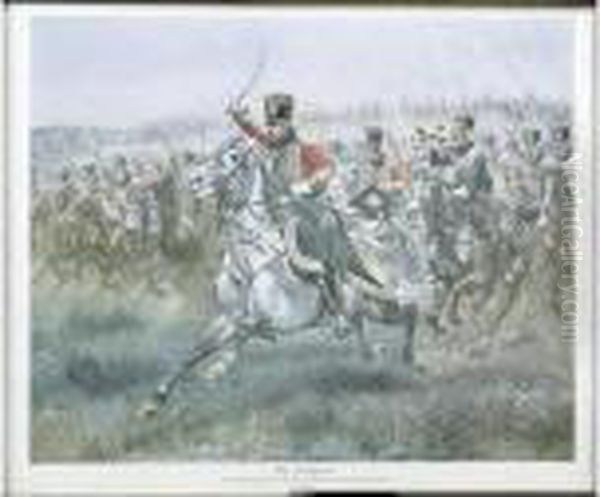
The pivotal experience in Detaille's life and art was the Franco-Prussian War of 1870-1871. Like many patriotic Frenchmen, he enlisted in the army, serving initially in the 8th Mobile Battalion. He experienced the realities of military life and the siege of Paris firsthand. During this period, he gathered invaluable direct observations, sketching soldiers, equipment, and scenes from the conflict. Some accounts suggest he even served briefly as a secretary to a general, giving him further insight into military operations.
This wartime experience profoundly shaped his artistic vision. It provided him with authentic subject matter and imbued his work with a sense of immediacy and realism that resonated deeply with the French public, particularly in the aftermath of the nation's defeat. The war fueled a desire for depictions of French military valor, endurance, and sacrifice, themes Detaille was uniquely positioned to address.
Following the war, Detaille produced a series of paintings based on his experiences and observations. Works like Les Vainqueurs (The Victors) (1872), depicting the grim reality of German troops entering a ravaged French village, showed the sobering side of conflict. Conversely, paintings like Salut aux Blessés! (Salute to the Wounded!) (1877), portraying a respectful encounter between French and German officers during a ceasefire, highlighted moments of military decorum and humanity amidst the strife. His depictions of the war cemented his reputation as an artist who could capture both the heroism and the hardship of military life with unparalleled accuracy.
Peak Career and Artistic Style
Throughout the 1870s and 1880s, Detaille reached the peak of his fame and artistic production. His style matured into a highly polished academic realism, characterized by an almost photographic attention to detail. He was meticulous in his research, ensuring the absolute accuracy of uniforms, weaponry, and horse tack for the specific period and regiment depicted. His studio became a repository of military artifacts – uniforms, helmets, sabers, rifles – which he used as references.
Detaille often employed models, dressing them in the appropriate uniforms and posing them to achieve the desired composition. His draftsmanship was exceptional, forming the solid foundation upon which his detailed paintings were built. While realism was paramount, his works were not merely static illustrations. He skillfully composed scenes to convey narrative, drama, and emotion, often focusing on moments of camaraderie, tension before battle, the fatigue of a march, or the solemnity of a military review.
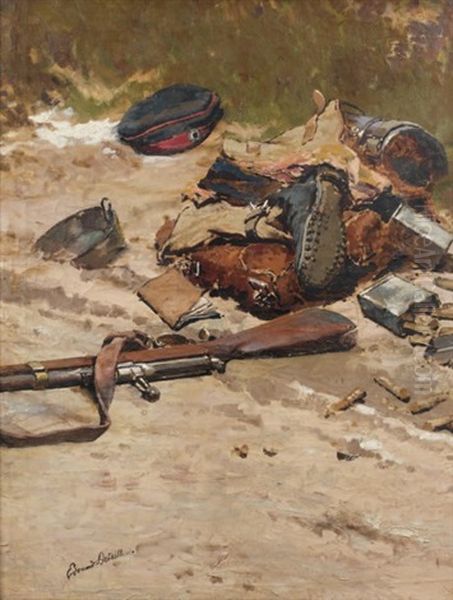
His paintings covered a wide range of military subjects, from contemporary scenes of the Third Republic army during maneuvers, like La Revue de Châlons (The Review at Châlons), to historical reconstructions of earlier conflicts, particularly the Napoleonic Wars. He excelled at depicting cavalry charges, infantry formations, and artillery batteries in action, capturing the movement and energy of these scenes while maintaining his signature precision. His palette was generally sober and realistic, accurately rendering the colors of uniforms and the tones of the landscape or battlefield.
Napoleonic Themes
A significant portion of Detaille's oeuvre was dedicated to the Napoleonic era. France, particularly after the defeat of 1871, experienced waves of nostalgia for the perceived glory days of Napoleon Bonaparte's First Empire. Detaille tapped into this sentiment, producing numerous paintings that celebrated the Grande Armée and its legendary leader. These works often blended historical accuracy with a touch of romantic heroism.
His depictions of Napoleon himself, often shown reviewing troops or leading his staff, became iconic. He painted various regiments of the Imperial Guard, cuirassiers, dragoons, hussars, and infantry, capturing the distinctiveness of their elaborate uniforms with painstaking care. Works like Vive L'Empereur! (1891), depicting a dramatic cavalry charge past Napoleon, exemplify his ability to combine historical detail with patriotic fervor.
Perhaps his most famous work, Le Rêve (The Dream) (1888), masterfully bridges the contemporary army with its Napoleonic heritage. It depicts young French soldiers sleeping on a battlefield during maneuvers, dreaming of their glorious predecessors – the ghostly legions of the First Empire marching across the sky. This painting became immensely popular, symbolizing the continuity of French military spirit and the enduring legacy of Napoleon. It perfectly captured the mood of national pride and longing for past military greatness prevalent in the Third Republic.
Collaboration with Alphonse de Neuville
In the realm of military painting, Detaille's closest contemporary and sometimes collaborator was Alphonse de Neuville (1835-1885). De Neuville shared Detaille's focus on military subjects, particularly scenes from the Franco-Prussian War, and possessed a similar commitment to accuracy, though perhaps with a slightly more dramatic or anecdotal flair at times. They were the two dominant figures in French military art during this period.
Their most significant joint project was the illustration of L'Armée Française: Types et Uniformes (The French Army: Types and Uniforms), a comprehensive two-volume work published between 1885 and 1889 (though initiated earlier, likely around 1883 as mentioned in the source text, with publication extending after Neuville's death). This ambitious publication featured hundreds of illustrations by both artists, meticulously documenting the uniforms, equipment, and various branches of the French army throughout its history. It remains an invaluable resource for military historians and uniformologists.
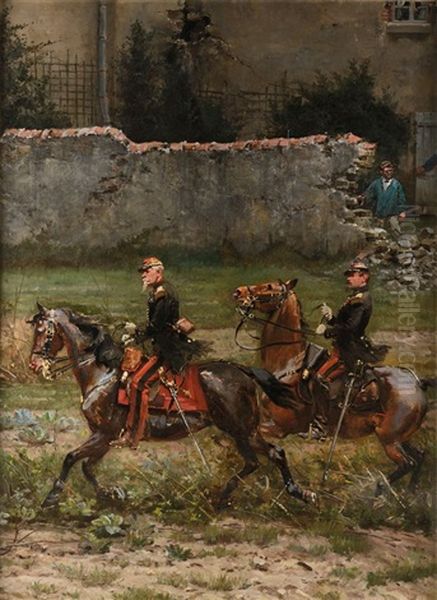
Detaille and de Neuville also collaborated on large-scale panoramic paintings, a popular form of public entertainment in the late 19th century that offered immersive, 360-degree views of historical events. They worked together on the Panorama de la bataille de Champigny (Panorama of the Battle of Champigny) (1882) and the Panorama de la bataille de Rezonville (Panorama of the Battle of Rezonville) (1883). These massive undertakings required coordinated effort and showcased their shared expertise in depicting complex battle scenes on a grand scale, further solidifying their status as the leading military artists of their day. The painter Paul Philippoteaux was another notable creator of panoramas during this era, highlighting the genre's significance.
Exhibitions, Recognition, and Official Role
Detaille enjoyed consistent success at the Paris Salon, the premier art exhibition venue of the time. He exhibited regularly from his debut in 1867 until the Salon system evolved. His works were eagerly anticipated by the public and generally well-received by critics, who praised his technical skill and accuracy, even if some found his subject matter repetitive or overly nationalistic. He received numerous awards, including medals at the Salons and a Grand Prix at the Exposition Universelle of 1889 in Paris.
His popularity extended beyond France; his works were exhibited and collected internationally. He became a member of the prestigious Académie des Beaux-Arts in 1892, succeeding his former master, Meissonier. This election confirmed his status within the official French art establishment, a world largely dominated by academic painters like Jean-Léon Gérôme and William-Adolphe Bouguereau, though Detaille's focus was more specialized.
Detaille also played a significant role in the preservation and promotion of military history. He amassed a large personal collection of military artifacts, including uniforms, weapons, and documents. A substantial part of this collection was later bequeathed or donated to the Musée de l'Armée (Army Museum) in Paris, located at Les Invalides. He was actively involved in the museum's organization and development, helping to shape its collections and displays, ensuring that the material culture of the French army was preserved for future generations.
Detaille and the Wider Art World
While Detaille operated firmly within the academic tradition, the late 19th century was a period of radical artistic change in Paris. The Impressionist movement, led by artists like Claude Monet, Edgar Degas, and Camille Pissarro, challenged the very foundations of academic art with their focus on capturing fleeting moments, the effects of light, and modern life, using looser brushwork and brighter palettes. Detaille's meticulous realism and historical/military subject matter stood in stark contrast to these avant-garde developments.
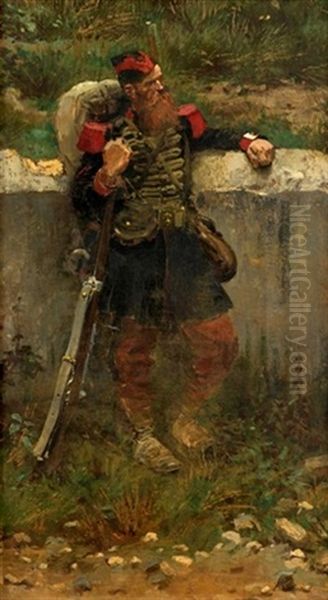
He remained largely untouched by Impressionism and subsequent movements like Post-Impressionism or Fauvism. His artistic lineage traced back more directly through Meissonier to earlier masters of historical and military painting, such as Horace Vernet, whose grand battle scenes were popular earlier in the century, and even Théodore Géricault and Eugène Delacroix, who had tackled military themes with Romantic intensity. Detaille represented the continuation and refinement of this specific genre within the established academic framework.
Interestingly, despite his traditional artistic approach, Detaille showed an early appreciation for a different kind of realism – photography. He was among the first collectors of the work of Eugène Atget, the photographer renowned for his documentary images of "Old Paris." This suggests an underlying appreciation for objective visual recording, which aligns with Detaille's own painstaking approach to accuracy in his paintings, even though their chosen mediums and aesthetics differed significantly. Other academic contemporaries included artists like Aimé Morot and Pascal Dagnan-Bouveret, who explored different facets of realism and naturalism.
Anecdotes and Personal Life
Detaille's life revolved heavily around his work and his passion for military history. His studio was described as a museum in itself, filled with the tools of his trade and his extensive collection of militaria. He was known for his dedication and methodical working process. His military family background undoubtedly provided him with connections and a deep understanding of the milieu he depicted.
His service during the Franco-Prussian War was not merely a passive observation; he actively participated as a soldier, lending authenticity to his later depictions. The anecdote about him potentially serving as a general's secretary, if true, would have given him an even closer view of military command and operations. His commitment to accuracy was legendary; he would reportedly spend hours ensuring the correct number of buttons on a uniform or the precise shape of a shako plate.
His collaboration with de Neuville appears to have been a professional relationship built on mutual respect and shared interests within their specialized field. Beyond this, information suggests he maintained connections within the established art world and military circles. His role in collecting Atget's photographs reveals a broader visual curiosity. His dedication to the Musée de l'Armée underscores his commitment to preserving the history he so meticulously painted.
Legacy and Influence
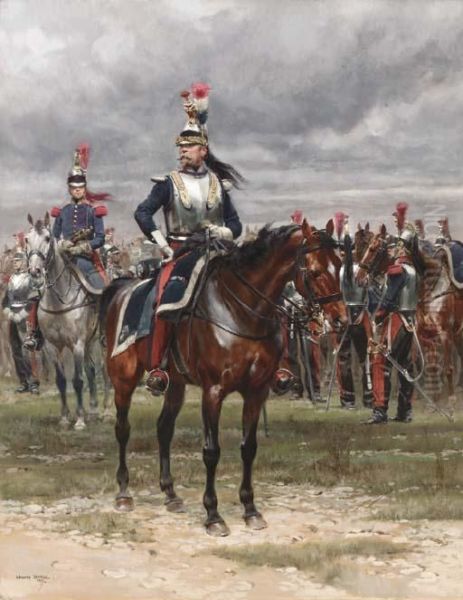
During his lifetime, Jean Baptiste Édouard Detaille was arguably the most famous and financially successful painter in France. His works commanded high prices, were widely reproduced as prints, and shaped the popular visual understanding of French military history, particularly the Napoleonic Wars and the Franco-Prussian War. His paintings adorned public buildings and private collections, embodying national pride and military tradition.
His influence extended to other artists specializing in military subjects. His accuracy and detailed style set a standard for the genre. After his death in 1912, and particularly following the cataclysm of World War I which rendered earlier depictions of warfare almost quaint, the style of academic military painting he represented fell somewhat out of fashion. Modern art movements continued to move away from traditional realism.
However, Detaille's work has retained its historical importance. His paintings remain invaluable resources for studying military uniforms, equipment, and formations of the periods he depicted. They offer a vivid, if often idealized, glimpse into the life of the French soldier in the 19th century. His contributions to the Musée de l'Armée ensured the preservation of tangible military heritage alongside his artistic interpretations. The Société des Peintres Militaires Officiels (Society of Official Military Painters) in France, which continues to this day, owes much to the tradition established by artists like Detaille and Neuville.
Conclusion
Jean Baptiste Édouard Detaille was more than just a painter; he was a visual historian of the French military. Rooted in the academic tradition and profoundly influenced by his master Ernest Meissonier and his own wartime experiences, he developed a style defined by extraordinary realism and meticulous attention to detail. From the battlefields of the Franco-Prussian War to the legendary campaigns of Napoleon, Detaille captured the French army with unparalleled precision and often with palpable patriotic sentiment. His collaborations, particularly with Alphonse de Neuville, and his contributions to the Musée de l'Armée further cemented his central role in the documentation and celebration of French military life. While artistic tastes evolved after his death, Detaille's work endures as a remarkable testament to his skill and dedication, and as a vital visual chronicle of a significant era in French history.